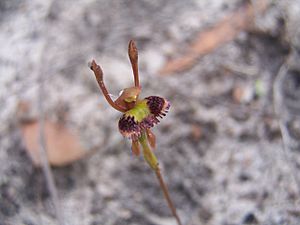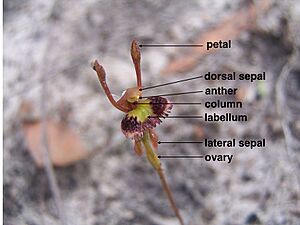Fringed hare orchid facts for kids
Quick facts for kids Fringed hare orchid |
|
|---|---|
 |
|
| Scientific classification | |
| Genus: |
Leporella
|
| Species: |
fimbriata
|
| Synonyms | |
|
|
The Fringed Hare Orchid, known scientifically as Leporella fimbriata, is a unique flowering plant. It is the only species in its group, called Leporella. This special orchid belongs to the orchid family, Orchidaceae. You can find it growing only in southern Australia.
It is related to spider orchids (genus Caladenia). However, the Fringed Hare Orchid has a very unusual labellum, which is a modified petal. Unlike some other orchids, its leaves are not hairy. The way this orchid gets pollinated is also quite interesting and unique.
Contents
What Does the Fringed Hare Orchid Look Like?
The Fringed Hare Orchid is a perennial plant, meaning it lives for more than two years. It grows from an oval-shaped underground tuber, which is like a small storage organ. This tuber helps the plant survive through dry periods. Each year, the tuber produces new "droppers" that grow into new tubers for the next year. These new tubers form a bit away from the parent plant.
At the base of its stem, the orchid has one or two smooth, egg-shaped leaves. These leaves are often small when the orchid flowers. But they grow larger, up to 40 mm (1.6 in) long and 20 mm (0.8 in) wide. As they get older, they turn a bluish-green color with reddish veins.
Fringed Hare Orchid Flowers
The Fringed Hare Orchid has up to three flowers on a thin stem. This stem can be 10 to 25 cm (3.9 to 9.8 in) tall. Each flower is about 1 to 3 cm (0.4 to 1.2 in) long and 1 cm (0.4 in) wide.
The top sepal (a leaf-like part protecting the flower bud) is curved over the labellum. The two side sepals are very narrow and bend back towards the stem. Like most orchids, one petal is specially shaped into the central labellum. The other two petals stand upright. They are narrow, about 10 to 12 mm (0.39 to 0.47 in) long, and have a club-like end with many tiny hairs.
The labellum itself is about 5 mm (0.2 in) long and 10 mm (0.4 in) wide. It is hairy and greenish with reddish-brown spots. It also has a comb-like fringe, which gives the orchid its "fringed" name. The parts of the flower involved in reproduction are joined together into a structure called the column. This column has wing-like parts on its sides.
The Fringed Hare Orchid usually flowers from March to June. Even after the flowers fade, you can often still see their remains until September. The plant then produces a dry fruit called a capsule. This capsule contains many tiny seeds.
How the Fringed Hare Orchid Got Its Name
This orchid was first officially described in 1840 by a person named John Lindley. He called it Leptoceras fimbriata. Later, in 1971, Alex George created the new group, or genus, called Leporella, and placed this orchid in it.
The name "Leporella" comes from a Latin word, lepus, which means "hare." The ending -ella means "little." So, Leporella means "little hare." The second part of its scientific name, fimbriata, is also a Latin word. It means "fringed," referring to the comb-like edge of its labellum.
Where the Fringed Hare Orchid Lives
The Fringed Hare Orchid typically grows in woodlands or shrublands. You might also find it in heathlands or in areas that can get swampy during winter.
It is found across the southern part of mainland Australia. This includes the western half of Victoria, southern South Australia, and southern Western Australia. In Western Australia, it grows from Shark Bay in the north down to Israelite Bay on the south coast. In South Australia, it is found in the south-east, especially the Yorke Peninsula and Eyre Peninsula. In Victoria, it grows in the south-west, including the Anglesea area and the outer suburbs of Melbourne.
How the Fringed Hare Orchid Reproduces
The Fringed Hare Orchid has a very interesting way of getting pollinated. It is a myrmecophyte, which means it has a special relationship with ants. This orchid is pollinated by a male bull-ant (specifically Myrmecia urens).
The orchid's labellum looks and smells like a female bull-ant. This tricks the male bull-ant into trying to mate with the labellum. As the ant attempts to do this, pollen from the orchid sticks to its body. When the ant visits another Fringed Hare Orchid, it transfers the pollen, helping the orchid to reproduce. This clever trick ensures the orchid's survival!


